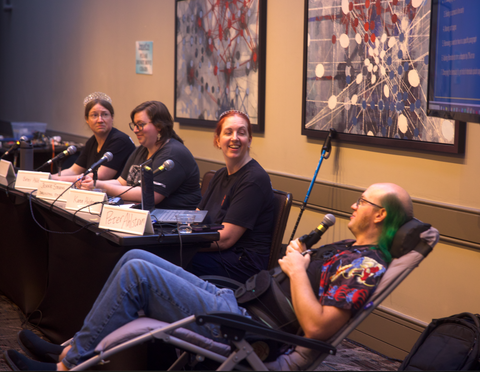At JordanCon this year, Dragonsteel’s editorial team gave fans an incredible peek behind the scenes of how Wind and Truth was brought into the world. If you thought the battle for Roshar was intense, wait until you hear about the spreadsheets, beta-reader marathons, and layout sorcery the editorial team wielded to get this book to you!
There’s so much more to the making of a story than the words on the page—how those words get there is a story in and of itself.
Meet the Editorial Avengers
First, let’s introduce the heroes of the story:
- Peter Ahlstrom was Brandon’s very first full-time employee, joining Dragonsteel back in 2009. Over the years, his titles have evolved alongside the company’s growth, and today he’s the vice president of editorial.
- Karen Ahlstrom was one of the earliest pillars of Dragonsteel’s team, stepping in when Peter needed backup managing the ever-sprawling internal wiki. Karen’s work on the continuity of the Cosmere is, frankly, one of the great unseen forces keeping the universe running smoothly.
- Kristy Gilbert is Dragonsteel’s editorial director, and our resident layout witch with a book o’ spells and everything. She makes sure everything actually fits in the book you’ll hold in your hands.
- Jennie Stevens joined Dragonsteel during the frenzy of the 2022 Kickstarter boom. (Because if you’re going to dive into Dragonsteel, why not do it during one of the most chaotic and exciting times imaginable?) She lives in Washington state with her family, where she wrangles commas in the comfort of her well-stocked library.
- Betsey Ahlstrom, Peter’s sister, joined the team in 2020—right in the thick of Rhythm of War’s editorial cycle. (If that isn’t a trial by fire, I don’t know what is.)
- Emily Shaw-Higham was an instrumental part of the Wind and Truth process, with her quick, thorough work and sharp eyes. She lives in Utah with her husband and just dyed her hair the most stunning shade of purple you’ve ever seen.
Between them, the team has decades of Cosmere knowledge, sharp eyes for continuity, and a frankly heroic capacity for processing a large volume of words.
Editing a Book...While Still Writing the Book
Normally, production on a book doesn’t start until after the draft is finished. Makes sense. Sanderson books are built differently though. Literally.
Peter broke down Brandon’s writing process for this book: "When Brandon was writing this book, he wrote Kaladin and Szeth’s plot from the beginning all the way through to the end. Then he went back and did Dalinar and Navani, and then he went back and did Shallan and Renarin and Rlain, and then he went back and did Adolin through the end, and finally he went back and sprinkled in the final touches."
Because of that structure, sections of the novel were ready to move into editing before other sections had even been written. That meant Dragonsteel had to build a working production schedule middraft. It was an incredibly delicate balancing act.
To pull it off, Peter created spreadsheets as intense as a Sanderson magic system to chart every moving part:
- Which sections were ready for beta readers.
- Which parts were safe to start copyedits.
- Which deadlines Brandon needed to hit for continuity’s sake.
- How the internal and external teams needed to rotate through phases without stepping on each other’s toes.
… and much more.
It was a herculean task. And of course, everything had to happen fast enough to meet printing deadlines without compromising the story’s quality.

The Betas, the Arcanists, and the Million-Word Mountain
Once beta readers got their hands on the book, the next tidal wave hit: 1.3 million words of feedback.
Pause for a moment and let that number sit in your brain. That’s nearly triple the size of Wind and Truth.
This is valuable feedback, so it’s not something the team skims through. No, they take the time to digest every piece of feedback; every comment was read, sorted, and considered.
Karen led the organizational charge here, working with Betsey and Emily to develop a system to:
- Isolate individual sentences or suggestions from the feedback.
- Label them with specific topics (character arc, worldbuilding, dialogue issues, etc.).
- Compile them into a sortable database, which made it much easier for Brandon and the team to navigate the sheer scope of reader suggestions.

It wasn’t just about flagging typos or suggesting tweaks—it was about catching the small inconsistencies, the worldbuilding trip wires, and the moments where characters might feel out of alignment with their past selves.
Meanwhile, Karen, one of Brandon’s trusted weekly readers, was also double-checking the timeline at a granular level. She often worked closely with the Arcanists, a brilliant group of fans who specialize in the ultra-nerdy, number-crunchy side of the Cosmere. (We’re talking questions like: Exactly how much Investiture would it take to destroy that wall?)
"We love them," Karen said, grinning. "They really help out when we need some solid data."
Thanks to these deep dives, Dragonsteel now has the exact years major Cosmere events occurred—and yes, the exact day of when Mistborn: The Final Empire began compared to The Way of Kings. (If you’re freaking out internally, same.)
Layout Magic, Microscopic Cuts, and Proofreading
Even after all this, another dragon-sized hurdle remained: making the physical book actually fit inside the bounds of reality.
Wind and Truth is a beast, and there are only so many pages the printers can physically bind into a single volume. Dragonsteel negotiated a stretch to the maximum: sixty-four additional pages above normal.
But even that wasn’t quite enough.
Enter Kristy Gilbert, Dragonsteel’s editorial director and our in-house layout witch. She pulled off a small miracle by:
- Adjusting line, page, and chapter breaks.
- Fine-tuning each page’s layout to maximize space.
- Fitting every piece of art, every epigraph, every map, and every word into the page count without making the text too small or crowded.
"Kristy is a wizard at this," Peter said. "We managed to squeeze all the text in and we never got a comment complaining that the text is too squished, so that’s a huge win. She did an excellent job."
At one point, Kristy approached Brandon with very specific requests: if he could trim a few words from a couple of paragraphs, they could save entire pages—critical breathing room needed to fit everything without sacrificing aesthetics or readability.
It was a team dance: Brandon trimming surgical edits, Kristy adjusting layouts, and the entire staff walking the tightrope between form and function.
By the time Wind and Truth landed on Jennie Stevens’s desk for the final proofreading pass, the manuscript had already been hammered into impressive shape. Jennie noted that by this stage, there were usually only one or two minor errors per page—an outstanding feat for a book of this length. “That’s really impressive,” Jennie said. “That means everyone did a wonderful job before it came to me.”
Proofreading is much more than catching typos; it’s about ensuring readers stay fully immersed, never tripping over odd formatting or a last-minute inconsistency. Every minor tweak at this stage protects the reader’s emotional experience.
Character Audio Libraries
In a project that is unique within the publishing world, the team pulled archived audio clips from every Stormlight audiobook so that narrators Michael Kramer and Kate Reading could reference past pronunciations and inflections. Maintaining character voice continuity across a sprawling series like this isn’t easy—but thanks to the audio libraries, the dialogue stayed consistent.


At the End of the Ten Days
Bringing Wind and Truth to life was an extraordinary, complicated, and delicate operation, which never would have succeeded without a brilliant team working behind the scenes.
From Peter’s spreadsheets, to Betsey’s comment-sorting magic, to Karen’s lore-keeping, to Jennie and Emily’s proofreading vigilance, to Kristy’s layout wizardry, every single person on Dragonsteel’s editorial team poured themselves into this book.
Next time you pick up Wind and Truth, remember: you’re not just holding a story. You’re holding a thousand moving pieces carefully arranged into a cohesive whole.




Comments (1)
This was so interesting to read! Thank you all for your hard work. It really does take a village 😃